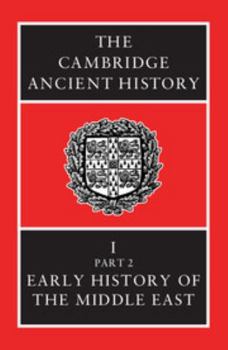The Cambridge Ancient History. Vol 1 Part 2: Early History of the Middle East
(Book #2 in the The Cambridge Ancient History, 2nd edition Series)
Select Format
Select Condition 
Book Overview
Part II of volume I deals with the history of the Near East from about 3000 to 1750 B.C. In Egypt, a long period of political unification and stability enabled the kings of the Old Kingdom to develop and exploit natural resources, to mobilize both the manpower and the technical skill to build the pyramids, and to encourage sculptors in the production of works of superlative quality. After a period of anarchy and civil war at the end of the Sixth Dynasty the local rulers of Thebes established the so-called Middle Kingdom, restoring an age of political calm in which the arts could again flourish. In Western Asia, Babylonia was the main centre and source of civilisation, and her moral, though not always her military, hegemony was recognized and accepted by the surrounding countries of Anatolia, Syria, Palestine, Assyria and Elam. The history of the region is traced from the late Uruk and Jamdat Nasr periods up to the rise of Hammurabi, the most significant developments being the invention of writing in the Uruk period, the emergence of the Semites as a political factor under Sargon, and the success of the centralized bureaucracy under the Third Dynasty of Ur.
Format:Hardcover
Language:English
ISBN:0521077915
ISBN13:9780521077910
Release Date:November 1971
Publisher:Cambridge University Press
Length:1058 Pages
Weight:3.85 lbs.
Dimensions:2.5" x 6.3" x 9.1"
Customer Reviews
2 ratings
Outstanding, though somewhat outdated
Published by Thriftbooks.com User , 16 years ago
The Cambridge Ancient History is a fantastic achievement. However, it began to be written 40 years ago, and it shows. The first few volumes (including this one) have been left far behind by new findings and modern scholarship, a situation that contrasts sharply with the volumes dealing with more "recent" times (particularly the Roman period), which were only just completed, contain state-of-the-art material and are far easier to read. The volumes dealing with the ancient Near East are badly in need of an update. Still, if you want an authoritative, broad (and dry) treatise that will point you in the right direction for further research, this is a good place to start. It would be unfair to demand richer narrative from a book dealing with a time when writing was still in the process being invented. However, the work does become overly tedious at times, particularly when discussing "remains" (i.e. barely recognizable foundations of buildings of ambiguous purpose). Field archaeologists may find it more palatable than armchair historians.
Ancient Near East
Published by Thriftbooks.com User , 17 years ago
I read this one awhile back and I enjoyed it very much although it was very technical. The book is profusely illustrated with maps, building plans, and tables. Great book (but very expensive) for history buffs.






